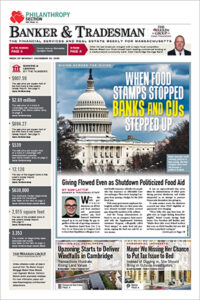
The inventory of available Boston Back Bay condominiums is currently 37-percent higher when compared with the pre-pandemic trailing 5-year average. Photo by Steve Adams | Banker & Tradesman Staff
Alan Greenspan, who reigned as chairman of the Federal Reserve for 18 years, was the master of “Fed-speak.” His descriptions of the state of the economy would leave analysts baffled. On the eve of the Great Financial Crisis, he let his guard down and gave a frank assessment when asked about the state of the housing market, saying that “at minimum, there’s a little froth” in the market.
I think Greenspan’s housing market description accurately describes the current state of the luxury real estate market. In Boston’s Back Bay, two single-family homes on Commonwealth Avenue were recently listed for nearly $30 million each.
Not to be outdone, another Back Bay property was offered (off the MLS) with an asking price of “$60-$70 million.” To get any details about that property you’ll need to provide the sales agent with proof of funds and sign a non-disclosure agreement.
According to MLS records, the highest price ever paid for a Back Bay single-family currently stands at $13 million. In the past 12 months, MLS PIN indicates that zero single family properties have sold in Back Bay proper. Yes, we know that there was a non-MLS sale, but this is clearly a highly illiquid market.
With the market a little frothy, here are a few things to keep an eye on.
It’s the Demand, Stupid!
It’s been my view that limited inventory has been masking weak underlying demand. Prices of existing properties in the downtown high-end market are basically flat. From a supply-and-demand standpoint, the market has been reasonably well balanced. That is changing and the pickup in supply could easily overwhelm lackluster demand.
The consensus view is that should interest rates moderate, fresh inventory will pop out of the woodwork and that supply will be met with endless demand – it’s a goldilocks scenario. However, in many luxury markets, inventories are already much higher than pre-pandemic levels.
The inventory of available condominiums in Boston’s Back Bay is currently 37 percent higher when compared with the pre-pandemic trailing five-year average. In upscale Brookline, the single-family home inventory is currently 22 percent higher versus the same pre-pandemic period.
Even in communities where inventory is still constrained, the near-term inventory trends are sharply higher. In Wellesley, single family home inventory is still 60 percent below pre-pandemic levels, but it’s now 54 percent above the post-pandemic three-year average.
Adjustable-Rate Mortgages a Time Bomb
According to CoreLogic, in January of 2021, when interest rates were at historic lows, only about 4 percent of mortgage originations nationwide were adjustable-rate mortgages (ARMs). By April 2023, 18.6 percent of conventional mortgage originations by dollar volume were ARMs.
No doubt homeowners with these adjustable-rate mortgages bought into the Realtor sales pitch of “marry the property, date the rate.” In other words, ignore interest rates, you can just refinance your mortgage when rates fall.
In the luxury market, there’s a misperception that buyers pay with cash and don’t get mortgages. Many high-end transactions are financed with mortgages, and in recent years they’re mostly ARMs.
A penthouse condominium unit in the Seaport District recently sold for $8.5 million. The purchase was financed with a $6.37 million mortgage – not unusual. What is noteworthy is the structure of the mortgage which has an initial 10-year interest-only period.
Used properly, interest-only mortgages can be a useful tool, but they carry meaningful risks compared with traditional mortgages. In the wake of the financial crisis, these types of loans were viewed as the ugly cousin of the “liar loan” – apparently IO’s are back in vogue.

Andrew Haigney
If you’re sitting on a 2021 vintage five-year ARM, you’re painfully aware of your reset date. While a wave of resets may not seem like a near-term concern, good investors understand the importance of anticipating the anticipation. We could see a spike in very motivated sellers well before the actual resets.
It’s anyone’s guess where interest rates will be down the road, but we remain skeptical that lower rates will stimulate robust demand and propel prices higher. To the contrary, an economic environment that warrants sharply lower interest rates may destroy demand.
Valuations feel a little frothy, inventory is piling up, interest rate resets are on the horizon, and the cost of home ownership is skyrocketing in the form of property taxes, insurance and other expenses. Is the real estate market whistling past the graveyard?
It should be noted that Greenspan’s frothy comment came in May 2005, more than three years before the failure of Lehman Brothers. Markets don’t always turn on a dime and things can stay frothy for a long time.
Andrew Haigney is principal broker at Batterymarch Group in Boston.






